Offered for sale are
2 ORIGINAL DOCUMENTS SIGNED BY LAST TREBLINKA COMMANDANT
SS-UNTERSTURMFüHRER KURT FRANZ
HE PARTICIPATED IN THE T-4 EUTHANSIA PROGRAM, WAS IN VARIOUS CONCENTRATION CAMPS AND LAST COMMANDANT OF TREBLINKA EXTERMINATION CAMP AND HE WAS TRIED FOR THE DEATHS OF 300,000 PEOPLE
FULL MONEY BACK GUARANTEE FOR AUTHENTICITY
The documents are dated 1939 and 1940 when Kurt Franz, at the time in the rank of SS-Unterscharführer, when he served in the 3. SS Totenkopfstandarte Thüringen, stationed in Buchenwald. His direct superior was SS-Obersturmführer Erich Rosenbusch.
The first document, signed by Kurt Franz is a list of Franz’ superior, the SS physicians in charge for him as well as his future wife, the two NSDAP Ortsgruppenleiter he lists who vouch for him (German: Bürgen) as well as personal information about his future wife, including her NSDAP membership number.
The second document is a SS form that Franz’ superior, SS-Obersturmführer Erich Rosenbusch, filled out and signed, in which he agrees to Franz’ marriage request that he wanted to send to the RSHA. Rosenbusch commanded several SS bataillons during the war, all the way to the end when he was appointed CO of the SS-Regiment ‘Falke’. He received the Deutsches Kreuz in Gold in 1942.
A very interesting pair of documents of one of the major perpetrators of genocide during the Holocaust.
SS-Untersturmführer Kurt Franz joined the Nazi Party in 1932 and was conscripted in the German Army in 1935. After performing the military service in October 1937, he joined the SS-Totenkopfverbände. First, he received training with the Third Death Head Regiment Thuringia at Weimar, and then served as cook and guard at the Buchenwald concentration camp, where he attained the rank of Unterscharführer (Corporal). In late 1939 Franz was summoned to Hitler’s Chancellery and detailed to take part in the Action T4 euthanasia program. Franz worked as a cook at Hartheim, Brandenburg, Grafeneck and Sonnenstein. In late 1941, he was assigned as cook at T4 headquarters. On 20 April 1942, Franz was promoted to Oberscharführer (Staff Sergeant). In spring of 1942, Franz, along with other veterans of Action T4, went to Lublin concentration camp complex in the Generalgouvernement, and was posted to the Bełżec extermination camp, where he stayed until the end of August 1942. With a change of command in the Operation Reinhard death camp system, Franz was transferred to Treblinka extermination camp. He quickly became the camp’s deputy commandant on the orders of Christian Wirth. He was promoted to serve as the last camp commandant from mid-August until November 1943 to conclude the Holocaust in Poland. At first, Kurt Franz supervised work commandos, the unloading of transports, and the transfer of Jews from the undressing rooms to the gas chambers. Franz had a baby-like face, and for this he was nicknamed “Lalke” (“doll” in Yiddish) by the prisoners. But Franz’s appearance belied his true nature. He was the dominant overseer in day-to-day interactions with prisoners in Treblinka, and he became the most feared man at Treblinka for the cruelty which he visited upon them. Franz was known for being unusually cruel and sadistic. He often made his rounds of the camp riding a horse, and would take his St. Bernard dog, Barry, along with him. Barry was trained to follow Franz’s command, which was usually to bite the genitalia or buttocks of prisoners.
Barry’s first owner was Paul Groth, an SS officer at Sobibor. Depending on his mood, Franz would set the dog on inmates who for some reason had attracted his attention. The command to which the dog responded was, “Man, grab that dog!” (German: Mensch, faß den Hund)—by “man”, Franz meant the dog Barry, and the “dog” was the human inmate whom Barry was supposed to attack, in an effort at dehumanization. Barry would bite his victim wherever he could catch him. The dog was the size of a calf so that, unlike smaller dogs, his shoulders would reach to the buttocks and abdomen of a man of average size. For this reason, he frequently bit his victims in the buttocks, in the abdomen and often, in the case of male inmates, in the genitals, sometimes partially biting them off. When the inmate was not very strong, the dog could knock him to the ground and maul him beyond recognition. When Kurt Franz was not around, Barry was a different dog. With Franz not there to influence him, the dog allowed himself to be petted and even teased, without harming anyone.
As reported by lower-ranking SS officers and soldiers, Kurt Franz also wrote the lyrics to a song which celebrated the Treblinka extermination camp. Prisoner Walter Hirsch wrote them for him. This song was taught to the few newly arriving Jews who were not killed immediately and were instead forced to work as slave laborers at the camp. These Jews were forced to memorize the song by nightfall of their first day at the camp.
Franz enjoyed shooting at prisoners or those still in the rail cars with his pistol or a hunting rifle. He frequently selected bearded men from the newly arriving transports and asked them whether they believed in God. When the men replied “yes”, Franz told each man to hold up a bottle as a target. He would then say to them, “If your God indeed exists, then I will hit the bottle, and if He does not exist, then I will hit you.” Then Franz would shoot at them. ‘Undoubtedly, [Kurt Franz] was the most terrifying of all the German personnel in the camp… witnesses agree that not a single day passed when he did not kill someone.’ Kurt Franz also had experience as a boxer before arriving at Treblinka. He put this training to sadistic use by victimizing Jews as punching bags. On occasion he would “challenge” a Jew to a boxing duel (of course the prisoner had to oblige), and gave the prisoner a boxing glove, while keeping one for himself, to give the illusion of a fair fight. But Franz kept a small pistol in the glove that he kept for himself, and he would proceed to shoot the prisoner dead once the gloves were on and they had assumed the starting boxing position. Franz was promoted to Untersturmführer (Second Lieutenant) and became an appointed official on 21 June 1943 on the orders of Heinrich Himmler. On 2 August 1943, Franz along with four SS men and sixteen Ukrainians went for a swim in the nearby Bug River, which depleted the security at Treblinka significantly and helped to improve the chances of success of the prisoner revolt that took place at the camp that day. After the revolt, the camp’s commandant Franz Stangl left. Kurt Franz served as his replacement, and he was instructed to dismantle the camp and to eliminate every trace of evidence that it had ever existed.[1] Franz had at his disposal some SS men, a group of Ukrainian guards and about 100 Jewish prisoners who had remained after the uprising. The physical work was carried out by the Jews during September and October 1943, after which thirty to fifty prisoners were sent to Sobibor to finish dismantling there, and the remainder were shot and cremated on Franz’s orders. After Treblinka, in late 1943, Franz was ordered to Trieste and northern Italy, where he participated in the persecution of partisans and Jews until the war’s end. He was wounded in late 1944 and, after recovery, employed as security officer on the Görz-Trieste railway line.
Following the war, Kurt Franz first worked as a laborer on bridges until 1949, at which point he returned to his former occupation as a cook and worked in Düsseldorf for 10 years until his arrest on 2 December 1959. A search of his home found a photo album of Treblinka with the title, “Beautiful Years”.
At the Treblinka Trials in 1965, Franz denied having ever killed a person, having ever set his dog on a Jew, and claimed to have only beaten a prisoner once. On 3 September he was found guilty of collective murder of at least 300,000 people, 35 counts of murder involving at least 139 people, and for attempted murder. He was sentenced to life imprisonment. He was released in 1993 for health reasons. Kurt Franz died in Wuppertal in 1998. In 2014, the New England Holocaust Institute and Museum acquired Kurt Franz’s uniform. [source: Wikipedia]
The documents ship from one of our affiliates in Germany. It comes from a private collection and has never been offered for sale before. It was purchased directly out of a German foundation. The seller gives a full money back guarantee for the authenticity of the documents and signature. Includes shipping worldwide.
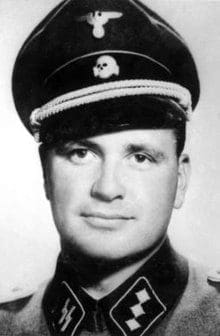
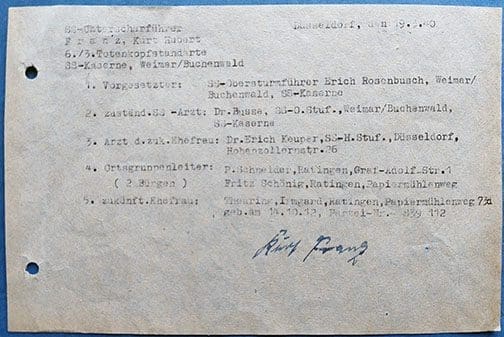
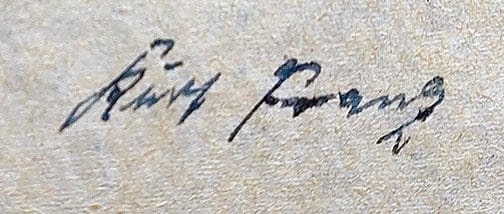


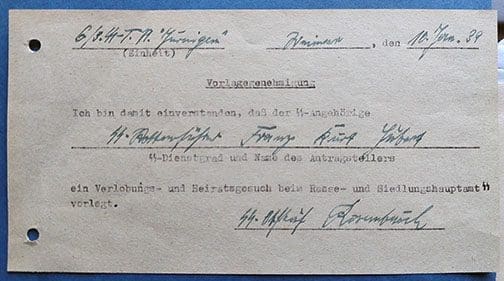

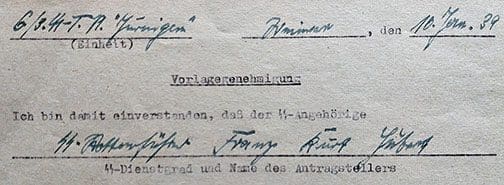
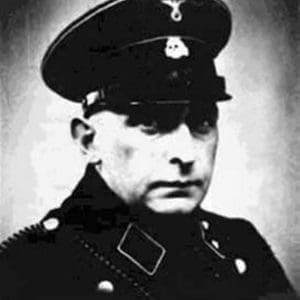

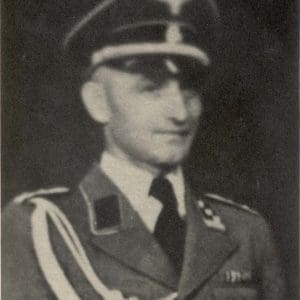
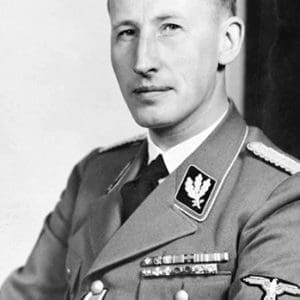
Reviews
There are no reviews yet.